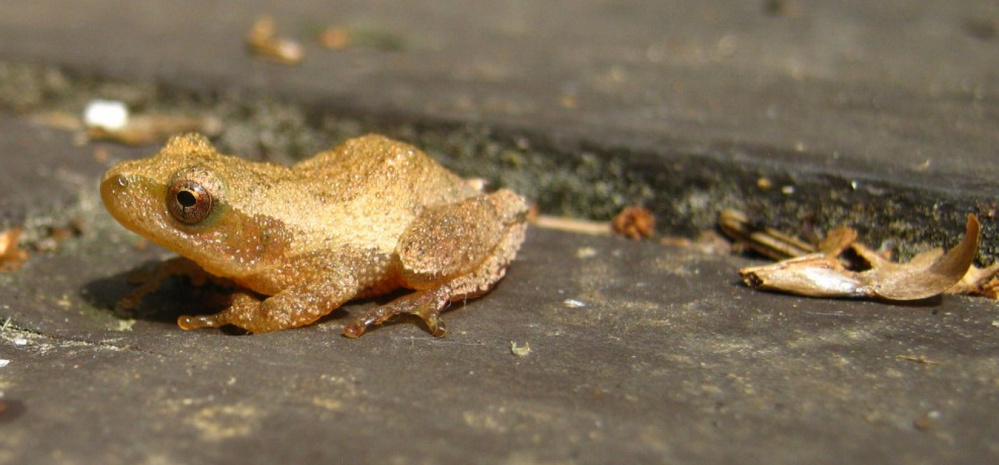At the end of this winter of our discontented warmth, a correspondent in Richmond reported that the peepers were already singing their springsong in his pond. The last of March, this was. The next evening in Belfast, I heard a full chorus piping away next to the junior high.
Here comes everybody already! The babel by the water is begunagain.
It was the pweet pweet pweet of peepers I heard in Belfast. In southern Maine, the wood frogs (Rana sylvatica) normally start piping up first around the end of March or beginning of April, late April farther north, according to “Maine Amphibians and Reptiles,” a University of Maine Press book. After that the northern leopard frogs (Rana (or Lithobates) pipiens) join the cacophony, then American toads (Anaxyrus (formerly Bufo) americanus) and pickerel frogs (Rana (or Lithobates) palustris) in May. A bit later come the green frogs (Rana (or Lithobates) clamitans), whose clunking indicates they spend much of the summer amorous; gray tree frogs (Hyla versicolor) when the temperature hits 68; mink frogs (Rana (or Lithobates) septentrionalis) in late June; and last the bullfrogs (Rana (or Lithobates) catesbeiana) who spend high summer rum-rumming like miniature alingual whales.
The spring peepers (Pseudacris crucifer, which sounds like a name in a Dickens novel) normally hop to the breeding sites around pools, ditches and ponds when the temperature starts topping 40 degrees, usually around mid-April. “May is the peak of the breeding season in Maine,” says the book, “and chorus activity is greatest on warm, rainy nights when light intensity is low.” That’s when the males’ distinct birdlike peeps — unlike the wood frogs’ snoring and quacking — fill the spring air. They linger along a swerve of pondshore or bend of puddle bay for weeks trying to attract females, who pop in for just a day or two to select a singer, mate and lay up to 900 eggs. The females’ hearing is apparently far superior to the males’, and they make their choices not by pitch — which they seem to hear while the males don’t — but by volume and quickness, preferring loud and fast to quiet and slow.
Who knows what they’re saying, exactly? Despite their miniature size — about an inch long, while the wood frogs are about 2 inches — their love utterances are loud, clear and chaotic. While the scientists colorfully call the din a “chorus,” to the nonfrog ear it shows no sign of punctuation of any sort and it’s hard to believe that wrucking, ratcheting and cheeping could be a call to love and lay eggs.
But to every thing there is a purpose, and the females obviously have some froggish socioevolutionary sense of what those bellowing boys mean because spring peepers are one of the most numerous vertebrates hereabouts, belting out incomprehensible lyrics together with all their other amphibian relatives. Brekkek kekkek, squawk and snore, trill and grunt, peep peep peep.
I’m a stump of a beech if I have any notion what they’re all saying there by their mini-waters of babalong, but every spring it rises like a dream from winter and heralds the great ricorsical awakening. I haven’t got the words to describe it exactly.
It got cold in early April when winter leered in for a last lash after laying pretty low in its allotted time and suckered the peepers out early. I hope they hunkered down and held out through the unfair April freeze.
Anyway, the birds are back. Chickadees are belting out their two-note half-step bulletins. A phoebe in the birch this morning. Black flies, earwigs, green grass, maple buds and tadpoles are on the way. Fish will be flipping fin again. Homecoming looks to be early this year.
Dana Wilde lives in Troy. You can contact him at naturalist1@dwildepress.net. Backyard Naturalist appears the second and fourth Thursdays each month.
Send questions/comments to the editors.




Success. Please wait for the page to reload. If the page does not reload within 5 seconds, please refresh the page.
Enter your email and password to access comments.
Hi, to comment on stories you must . This profile is in addition to your subscription and website login.
Already have a commenting profile? .
Invalid username/password.
Please check your email to confirm and complete your registration.
Only subscribers are eligible to post comments. Please subscribe or login first for digital access. Here’s why.
Use the form below to reset your password. When you've submitted your account email, we will send an email with a reset code.